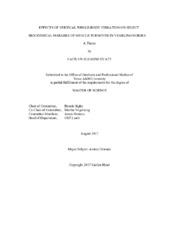| dc.description.abstract | This study was designed to determine the safety of vertical whole-body vibration (WBV) by measuring effects on select muscle biochemical markers in yearling horses on stall rest. Twenty yearling horses (17 ± 2 mon) were randomly divided into a split plot experimental design consisting of treatment (n=10) and control (n= 10) groups.
Horses were assigned uniform stalls by the Texas A&M University Horse Center and provided ad libitum access to water and trace mineral salt blocks. Horses were fed a diet for 100% of the NRC requirements for DE and 110% of the NRC requirements for protein, calcium, and phosphorus using 1.25% BW in Coastal Bermudagrass hay and 0.75% BW in pelletized concentrate.
The treatment group completed WBV on a vibration plate at 50 Hz 30 min per
day 5 d per wk for 120 d. Serum was collected via jugular venipuncture in 6-mL lithium heparin tubes on D 0, 30, 60, and 120 before 30-min of turnout in on-site paddocks, and after turnout (control group only) or vibration (treatment group only). Only an initial blood draw was collected on Day 0 as a baseline value to serve as a covariate to which all mean values were adjusted. Samples were analyzed by Texas A&M University Veterinary Medical Teaching Hospital Clinical Pathology Lab for blood urea nitrogen (BUN), aspartate aminotransferase (AST), gamma-glutamyltransferase (GGT), creatine kinase (CK), and lactic acid (LA) within 24 hr of collection. Statistical analysis was completed using the PROC MIXED procedure of SAS 9.4, and significance was set to P ≤ 0.05.
There was no significant difference found serum BUN concentrations between the treatment and control groups across days and between pre- and post-treatment concentrations. No significant differences in serum AST and GGT concentrations were found between the experimental groups. Serum CK values were significantly different (P = 0.0277) between the treatment and control groups after treatment. There was no significant difference in serum LA concentrations between experimental groups. However, both groups each had a significant difference (P < 0.05) in LA values between D 30 and D 60 and between D 30 and D 120.
Elevated serum CK and AST concentrations are indicative of muscle metabolism during work. The presence of LA in the blood is indicative of anaerobic metabolism after high intensity physical exercise. Serum GGT is a reliable biomarker used to differentiate between liver disease and healthy muscle metabolism when measured alongside CK concentration. Vertical WBV of young horses on stall rest has proven to be a safe therapeutic tool with little to no significant alterations in skeletal muscle biochemical markers over time. Further studies using uniform muscle biopsies and hourly blood collections post-vibration are recommended for further understanding of the potential therapeutic applications of WBV. | en |


